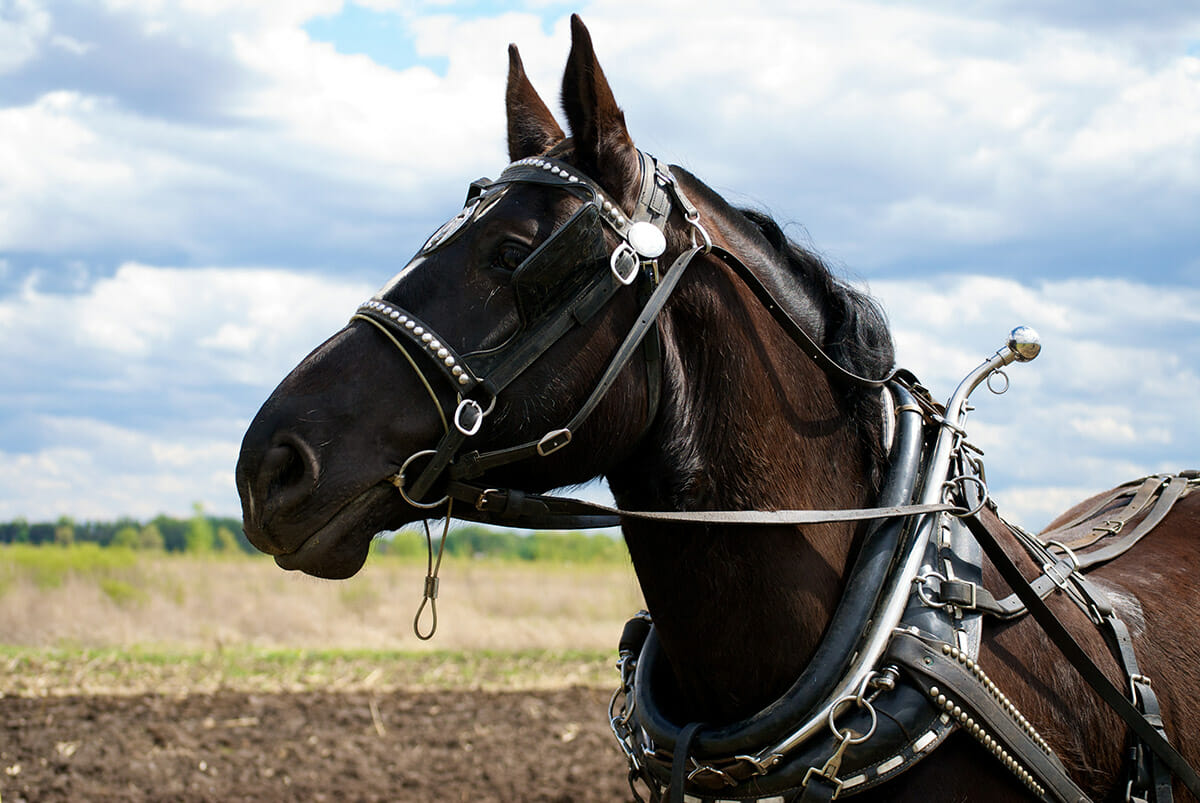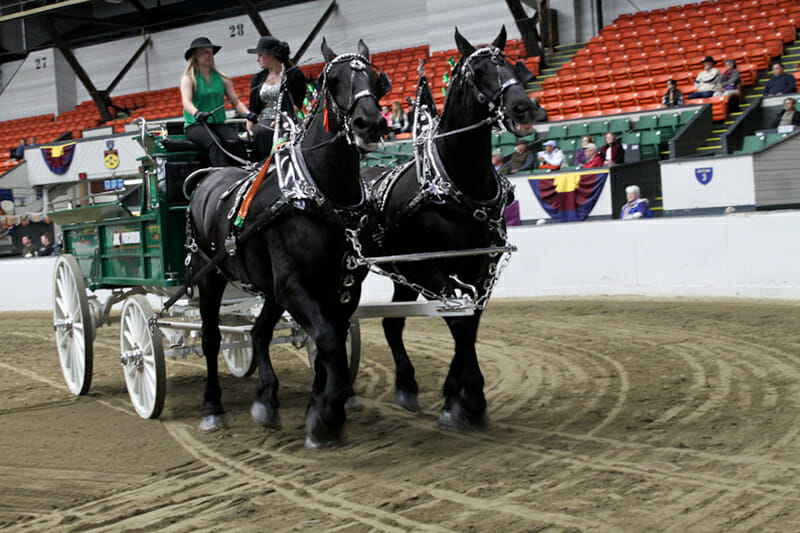The World Percheron Congress is both a venue for showmanship and a celebration of this incredible breed of draft horses.

Say “show animals” and most people picture dogs, not draft horses. But the World Percheron Congress is first and foremost a venue for showmanship. This year, more than 700 horses from more than 120 farms across the United States and Canada showed up for the five-day event.
The champion horse, YF Hillary’s Isabel (yes, that’s one name) of Anderson Farms, steps into the ring, led by a man whose head barely reaches her withers. She is a deep, shining black, with a small white blaze and one white foot. Her long neck is thickly muscled but elegant and her hooves, painted black, are the size of small dinner plates. During her victory lap at the closing ceremony, it is clear even to the untrained eye that this is one heck of a horse.
“I really think that they are kind of the premier show horse, the way they just show off in the ring,” says Justin Hussey of North Conway, New Hampshire. This is the Olympics of Percheron shows, says Hussey, and as with the Olympics, it has taken place just once every four years since its inception in England in 1978.
Hussey and his family are at the Congress with their grey geldings – neutered male horses – who compete in hitch classes, where the horses pull carts or wagons in a throwback to the breed’s 19th century duties. Percherons were often used to pull calliopes – instruments also known as steam organs – in traveling circuses, and Heinz ketchup used teams of Percherons much as Anheuser-Busch uses Clydesdales.
“The Clydes, of course, everybody in the world knows the Clydesdales,” says Jim Hilgendorf, a Congress vendor selling horse trailers. Hilgendorf drove those distinctive brown horses with feathered white feet for Anheuser for five years. “Belgians [the heaviest breed of draft horse] are the most powerful. Percherons, I would say they’re probably the dominant breed today as far as hitching and driving and wagons.”
Say “show animals” and most people picture dogs, not draft horses. But the World Percheron Congress is first and foremost a venue for showmanship.
“We feel like they’re more versatile than the Belgians and the Clydes,” says Hussey.
At the Congress, you can also enter your Percheron in a riding contest – there are both English and Western divisions – or a halter show, where your horse is judged according to how well it conforms to a breed ideal (“He should be close coupled and wide and deep through the chest, with plenty of back rib,” notes the Percheron Horse Association of America). YF Hillary’s Isabel is about as close to an ideal show Percheron as you can get. Working horses are, on average, smaller than show horses, which are bred to exhibit the sheer big-ness of the breed.
Nobody’s in it for the money: Most just hope to get enough prize winnings to partially cover the cost of transporting the horses. Most events pay between $100 and $400 for first place. The six-horse and eight-horse hitch classes pay $1,000 for a win. (There are other benefits to winning a ribbon, particularly in the halter classes. They boost a horse’s résumé, making it more attractive as a breeding animal).
There are contests for plowing to judge Percherons that still work in the fields, and contests for log hauling to judge those that still work in the forests. There are pulling contests to demonstrate the might of a two-horse team and obstacle courses to demonstrate their agility. There is even barrel racing: a staple of rodeos, it features quick-footed horses and their riders maneuvering around a course of strategically placed barrels at high speeds. Who knew a 2,000 pound animal could make those kind of turns?
Other gatherings and competitions for draft horses take place throughout the year, and there are even other breed-specific shows (next year the Clydesdales will get their turn in Ontario). But there is only one that is just for Percherons. If draft horses are a language unto themselves in the livestock world, then Percherons are their own special dialect. And here, among fellow enthusiasts, everyone’s speaking it.

Megan Bunnell (L) and Rebecca Palmer compete with percherons Mike and Murphy at this year’s Congress.
“I like their temperament,” says David Anderson of Ontario, owner of YF Hillary’s Isabel. “As a young boy, that’s what attracted me to them. I said when I got a little older and I could afford to do it, I’d have a few around. I didn’t think this many, but … ” he trails off. Anderson Farms owns about 50 Percherons.
“You can do this at any level that you want to,” says Albert Cleve of Blue Ribbon Farms in Farmington, Missouri. He has chaired two previous Congresses and co-chaired a third; this year, he took on the lighter load of selecting ribbons and trophies. Cleve is a hitch-class man himself (“The hitch class is really the king,” he says). He bought his first pair of Percherons in the mid-1980s. He’d always wanted them; his family had a team on the farm where he grew up. Cleve’s first pair turned into four, then six, then eight. At one point he owned 16. At 66, Cleve has retired from driving the team, but he’s no less invested in the horses. His mares (Unique, Emily, Crystal, Belle, Tabby and Melanie) compete in the six-horse hitch.
The Congress also included younger generations of Percheron fans. During the morning youth classes, Kaylee Edgerton of Chatsworth, Georgia, a tanned seventh-grader with brown hair and wide eyes, picked up a first place ribbon for her ride on Blue. At the end of the day, the Edgertons got another ribbon for their entry in the costume contest. Kaylee was Alice. Blue was the White Rabbit.
“I like their temperament… As a young boy, that’s what attracted me to them.”
“He’s comfortable to ride, and he likes to go,” Kaylee says, nonplussed by the thought of riding a horse that weighs about twenty times what she does. She’s been riding Blue since she was in “second or third grade.” Percherons are sweet, she says.
Over in a nearby barn, Hussey and his family lifted tack and gear off of Marshall, one of the grey geldings, after the horse got a sixth place ribbon in Ladies Cart. Drivers sit high off the ground in two-wheeled buggies, wearing Victorian clothing as they guide their horses – sporting silvery flowers in their manes to show off their long necks around the ring. Marshall wanted to win, Hussey says, but “today just wasn’t our day.”
Marshall is six years old, and stands 17.2 hands tall – about 5’7” – at the shoulder. Reaching his bridle requires a stepstool. He “probably weighs about 1900 pounds,” Hussey says. “He’s a little small.”
Marshall’s stable mate Johnny, on the other hand, stands 18.3 hands tall and weighs 2,230 pounds. He’s older, and his gray coat has turned white, which is common for Percherons. It’s also common for show Percherons to have their white coats dyed gray, so they match one another when they compete as teams.
“We just use regular women’s hair dye, but about 20 bottles of it,” Hussey says. People ask him why he doesn’t just use black Percherons, which don’t change color, but the farm is so closely associated with grays that he can’t imagine making the shift.
“It’s kind of a tradition thing for us,” he says.